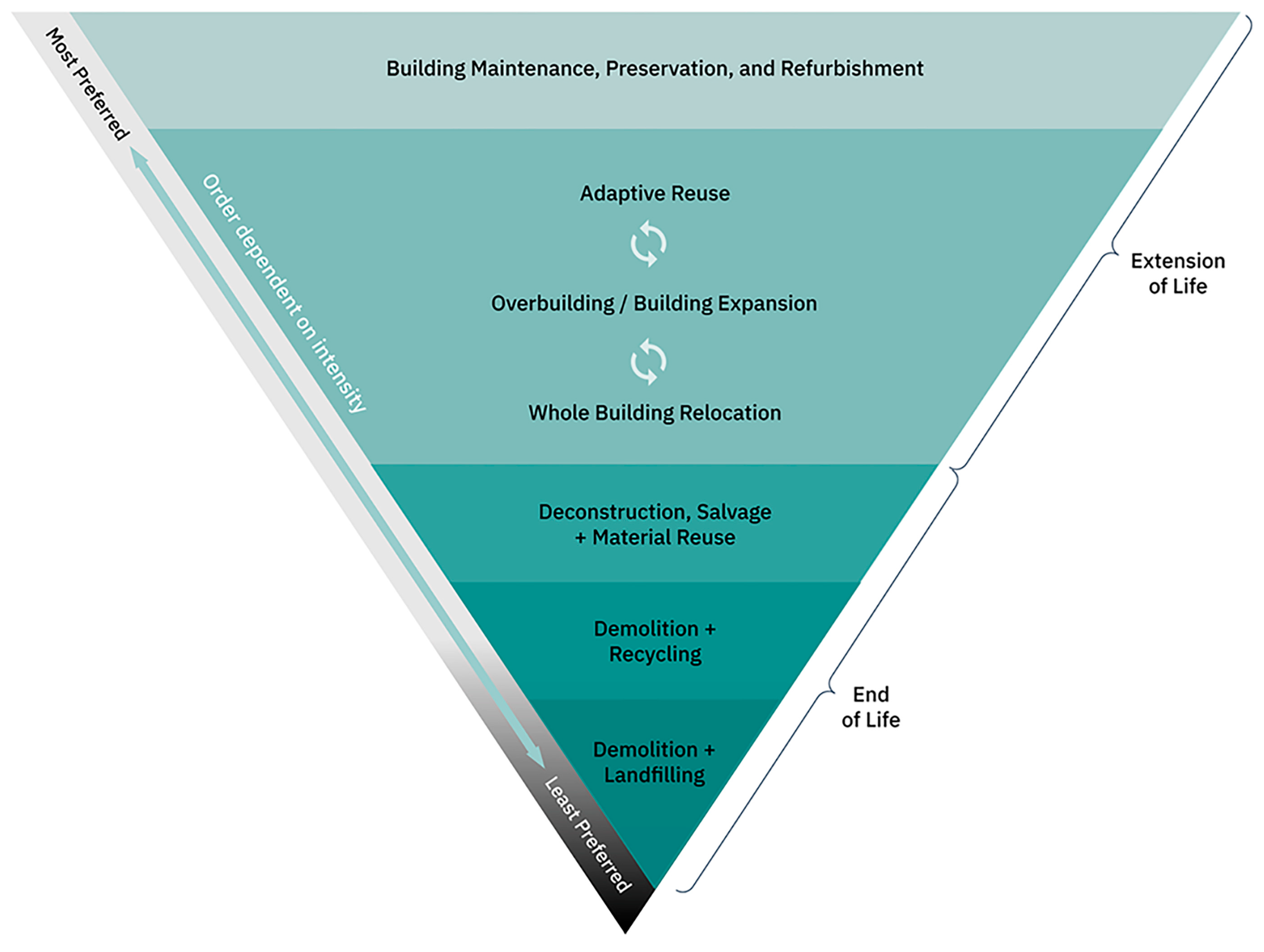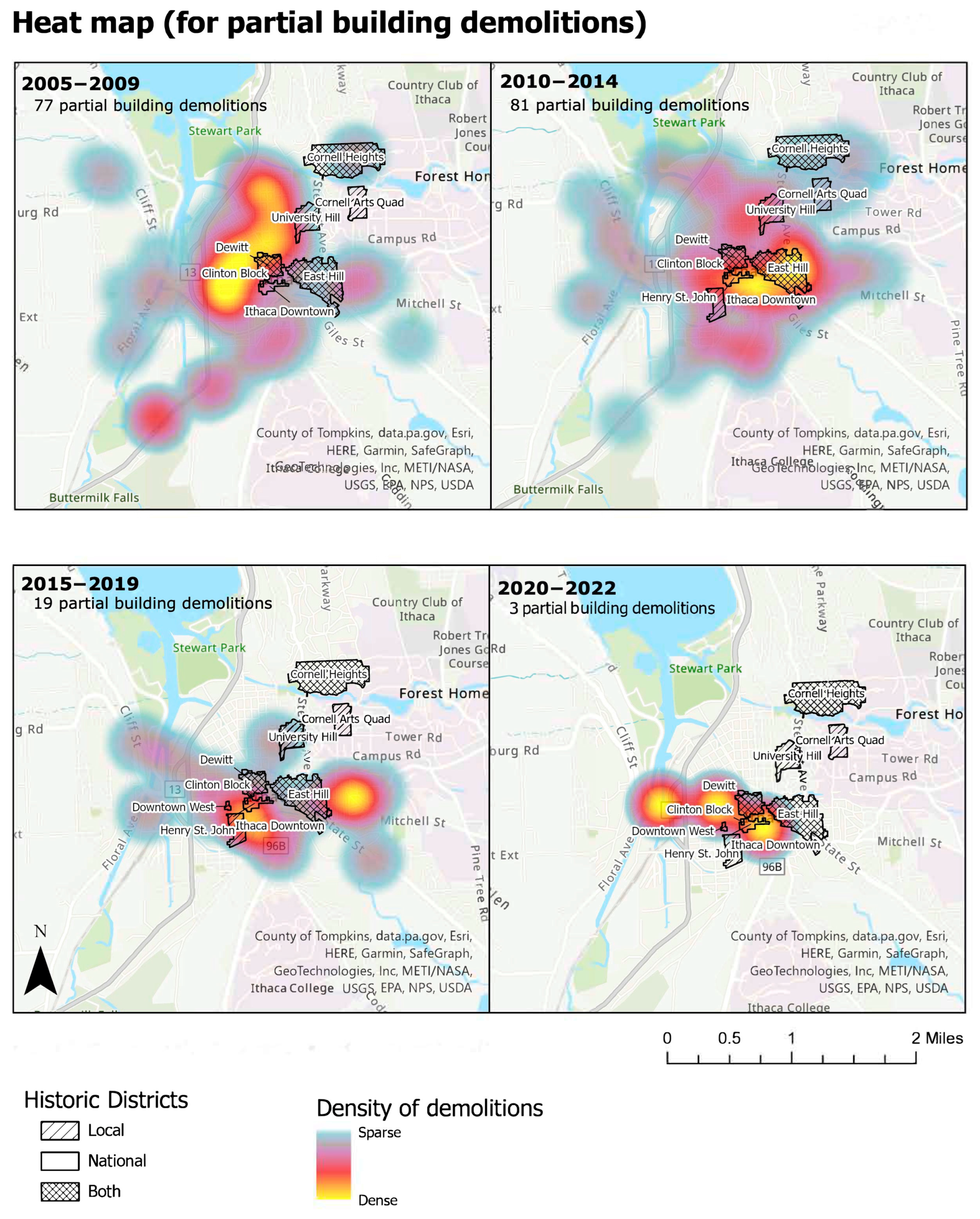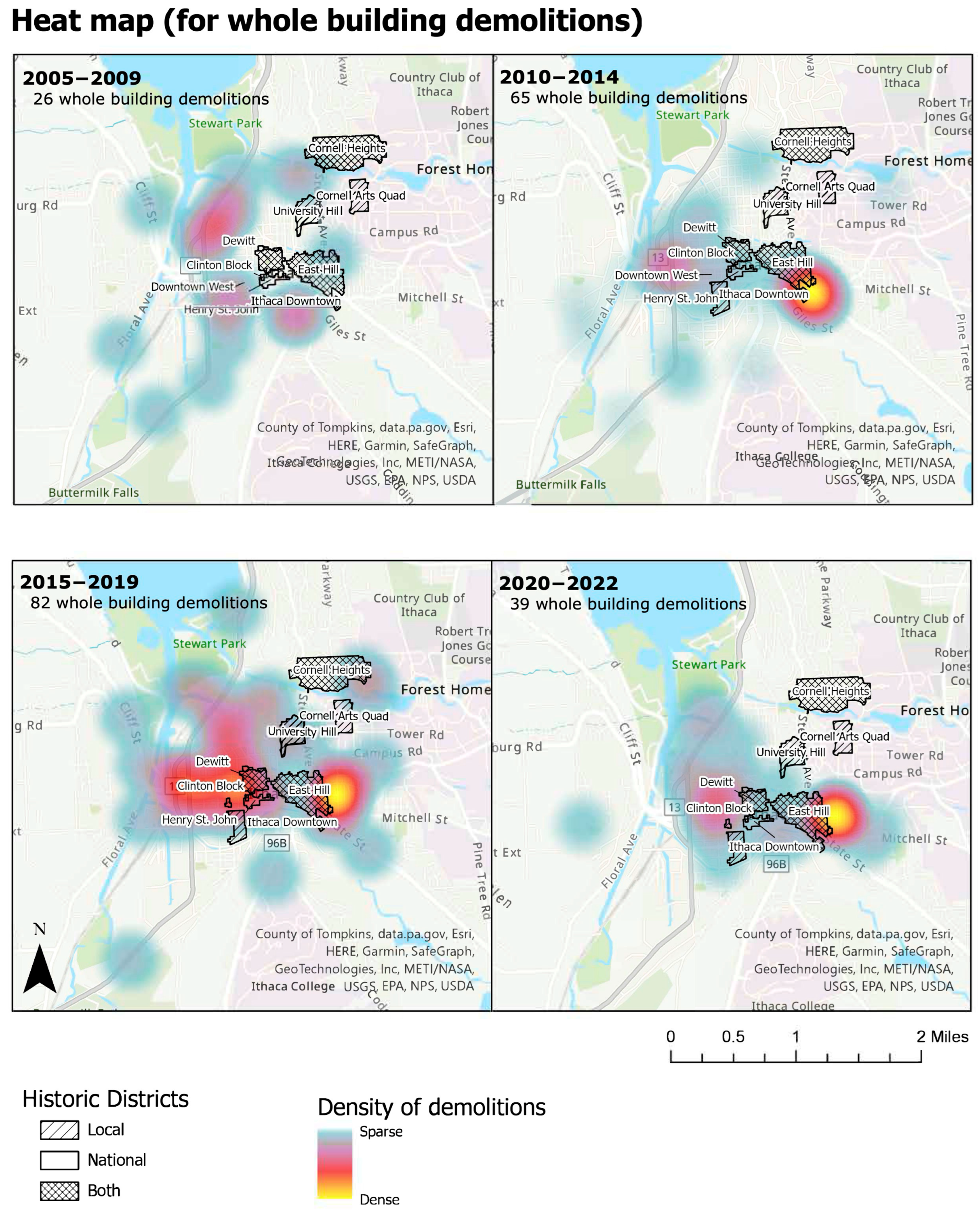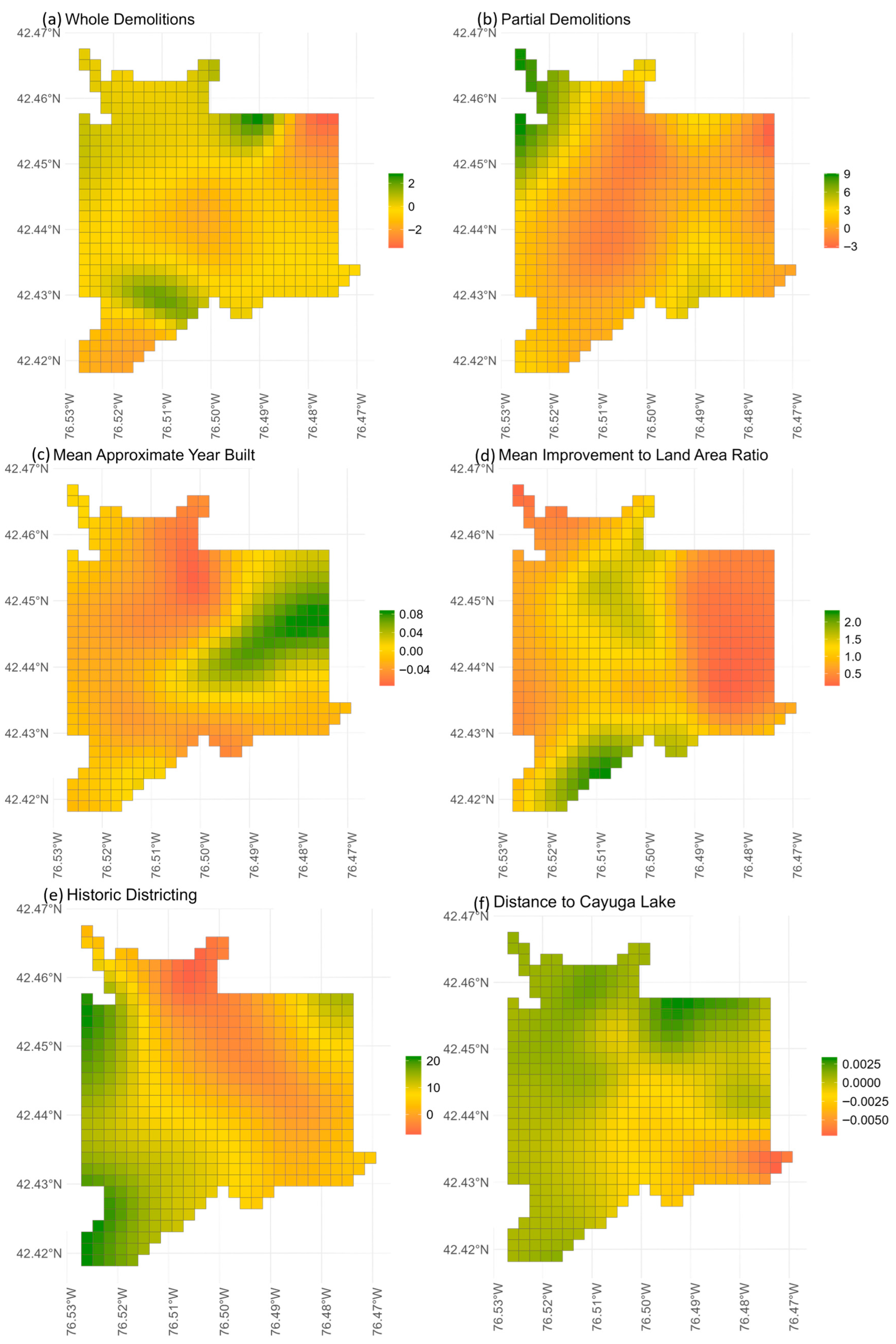Incremental Urbanism and the Circular City: Analyzing Spatial Patterns in Permits, Land Use, and Heritage Regulations
Abstract
1. Introduction
1.1. Shifting Focus from New Construction to Existing Building Stock
1.2. Mapping Building and Demolition Permits as Indicators of Urban Change
1.3. The Building Reuse to Waste Hierarchy
1.4. A Case Study of Sustainability and Circularity in Ithaca, New York
2. Methods
2.1. Collection and Classification of Data from Ithaca’s Building Permit Database
2.2. Exploratory Analysis and Demolition Pattern Mapping Offer Insight into Local Dynamics
2.3. Geographically Weighted Regression (GWR) of Reinvestment in Existing Building Stock
2.4. Machine Learning Using a Geographically Weighted Random Forest Model (GRF)
3. Results
3.1. Exploratory Heatmaps of Demolition Activity and Historic Districting
“The maps seem to track with what happened in terms of new policies and upzoning. The 1987 to 2004 hot spots appear to correspond with a lot of the development that Mack Travis discusses in his book [66]… Because the Collegetown construction moratorium ended in April 2009, it’s not surprising to see Collegetown from the creek to E. State to Dryden turned into a true demo hot spot. During the 2010s, so many new projects up there came online after the real estate crash of 2008 and the projects that were on standby waiting for the moratorium to be lifted were finally able to start. This was when a lot of that real estate became highly valued… Developers certainly saw the growth opportunity with student rentals. After 2015, you also see activity along the downtown corridor because that corresponds to the upzoning that went into effect in that zone.”(Christine O’Malley, 2022).
3.2. Outcomes from the OLS and GWR Modeling
3.3. Outcomes from the GRF Modeling
4. Discussion
4.1. Implications of Circularity in the Built Environment and Local Government Policy
4.2. Implications for Spatial Analyses in Small Cities and Data-Poor Contexts
4.3. Implications and Research Directions for Circularity in the Built Environment
5. Conclusions
Author Contributions
Funding
Data Availability Statement
Acknowledgments
Conflicts of Interest
Abbreviations
| GWR | Geographically Weighted Regression |
| GRF | Geographically Weighted Random Forest Model |
References
- Townsend, T.G.; Anhassi, M. Construction and Demolition Debris; Springer: Berlin/Heidelberg, Germany, 2023. [Google Scholar]
- Soto-Paz, J.; Arroyo, O.; Torres-Guevara, L.E.; Parra-Orobio, B.A.; Casallas-Ojeda, M. The circular economy in the construction and demolition waste management: A comparative analysis in emerging and developed countries. J. Build. Eng. 2023, 78, 107724. [Google Scholar] [CrossRef]
- Williams, J. Circular Cities: A Revolution in Urban Sustainability; Routledge: London, UK, 2021. [Google Scholar] [CrossRef]
- Paiho, S.; Mäki, E.; Wessberg, N.; Paavola, M.; Tuominen, P.; Antikainen, M.; Heikkilä, J.; Rozado, C.A.; Jung, N. Towards circular cities—Conceptualizing core aspects. Sustain. Cities Soc. 2020, 59, 102143. [Google Scholar] [CrossRef]
- Falah, N.; Falah, N.; Solis-Guzman, J.; Marrero, M. An indicator-based framework of circular cities focused on sustainability dimensions and sustainable development goal 11 obtained using machine learning and text analytics. Sustain. Cities Soc. 2025, 121, 106219. [Google Scholar] [CrossRef]
- Huuhka, S. Circularity in the Built Environment. In Proceedings of the 2025 Conference, Tampere, Finland, 16–18 September 2025; Tampere University: Tampere, Finland, 2025. [Google Scholar] [CrossRef]
- Williams, J. Circular cities: Planning for circular development in European cities. Eur. Plan. Stud. 2023, 31, 14–35. [Google Scholar] [CrossRef]
- Carbon Leadership Forum. Embodied Carbon 101. 2020. Available online: https://carbonleadershipforum.org/embodied-carbon-101-v2/ (accessed on 9 October 2025).
- Carbon Neutral Cities Alliance and One Click LCA. Carbon Neutral Cities: City Policy Framework for Dramatically Reducing Embodied Carbon; Carbon Neutral Cities Alliance: Denver, CO, USA, 2021; Available online: https://carbonneutralcities.org/wp-content/uploads/2021/02/City-Policy-Framework-for-Dramatically-Reducing-Embodied-Carbon.pdf (accessed on 9 October 2025).
- Circularity Reuse and Zero Waste Development Network. Toward Building Sustainable Communities and Circular Economies: A Local Government Policy Guide to Alternatives to Demolition Through Deconstruction and Building Reuse; Just Places Lab and CR0WD: Ithaca, NY, USA, 2023. [Google Scholar]
- Boeri, A.; Gaspari, J.; Gianfrate, V.; Longo, D.; Boulanger, S.O. Circular city: A methodological approach for sustainable districts and communities. Eco-Archit. VII Harmon. Between Archit. Nat. 2019, 183, 73–82. [Google Scholar]
- Heisel, F.; McGranahan, J.; Lucas, A.; Cohen, D.; Stone, G. Carbon, Economics, and Labor: A Case Study of Deconstruction’s Relative Costs and Benefits Compared to Demolition. J. Phys. Conf. Ser. 2023, 2600, 192003. [Google Scholar] [CrossRef]
- Ross, S. More Than Urban Mining: Salvaging Modern Material Discards for Meaningful Reuse. Change Over Time 2023, 12, 96–117. [Google Scholar] [CrossRef]
- City of Vancouver. Zero Emissions Buildings. Available online: https://vancouver.ca/green-vancouver/zero-emissions-buildings.aspx (accessed on 29 September 2025).
- Minner, J.; Poe, J.; Heisel, F.; Kopetzky, A.; Porath, M.; Worth, G. Embodying Justice in the Built Environment: Circularity in Practice; Cornell University: Ithaca, NY, USA, 2024; Available online: https://labs.aap.cornell.edu/sites/aap-labs/files/2024-04/Embodying%20Justice%20Workbook_240412.pdf (accessed on 1 May 2024).
- Hirt, S. Zoned in the USA: The Origins and Implications of American Land-Use Regulation; Cornell University Press: Ithaca, NY, USA, 2014. [Google Scholar]
- Bronin, S.C. Key to the City: How Zoning Shapes Our World, 1st ed.; W. W. Norton & Company, Incorporated: New York, NY, USA, 2024. [Google Scholar]
- The City of Minneapolis. Policy 1. Access to Housing: Increase the Supply of Housing and its Diversity of Location and Types, Minneapolis 2040. Available online: https://minneapolis2040.com/policies/access-to-housing/ (accessed on 10 January 2025).
- Local Housing Solutions. Zoning Changes to Allow for Higher Residential Density. 2021. Available online: https://localhousingsolutions.org/housing-policy-library/zoning-changes-to-allow-for-higher-residential-density/#:~:text=In 2019%2C Oregon banned single-family zoning through,than 10%2C000 residents would allow for duplexes (accessed on 10 January 2025).
- Glaeser, E.L. Triumph of the city: How our greatest invention makes us richer, smarter, greener, healthier, and happier. In Penguin Books; Macmillan: London, UK, 2012. [Google Scholar]
- Elefante, C. The Greenest Building Is... One That Is Already Built. Forum J. 2007, 21, 26–38. [Google Scholar] [CrossRef]
- Jacobs, D.E.; Cali, S.; Welch, A.; Catalin, B.; Dixon, S.L.; Evens, A.; Mucha, A.P.; Vahl, N.; Erdal, S.; Bartlett, J. Lead and other Heavy Metals in Dust Fall from Single-Family Housing Demolition. Public Health Rep. 2013, 128, 454–462. [Google Scholar] [CrossRef] [PubMed]
- American Institute of Architects. Buildings that Last: Design for Adaptability Deconstruction and Reuse; AIA: Washington, DC, USA, 2020; p. 5. Available online: https://content.aia.org/sites/default/files/2020-03/ADR-Guide-final_0.pdf (accessed on 1 October 2025).
- Heisel, F.; Hebel, D.E.; Webster, K. Building Better—Less—Different: Circular Construction and Circular Economy: Fundamentals, Case Studies, Strategies, 1st ed.; Birkhäuser: Basel, Switzerland, 2022. [Google Scholar]
- Chen, Z.; Feng, Q.; Yue, R.; Chen, Z.; Moselhi, O.; Soliman, A.; Hammad, A.; An, C. Construction, renovation, and demolition waste in landfill: A review of waste characteristics, environmental impacts, and mitigation measures. Environ. Sci. Pollut. Res. 2022, 29, 46509–46526. [Google Scholar] [CrossRef]
- Arora, M.; Raspall, F.; Cheah, L.; Silva, A. Buildings and the circular economy: Estimating urban mining, recovery and reuse potential of building components. Resour. Conserv. Recycl. 2020, 154, 104581. [Google Scholar] [CrossRef]
- Sdino, L.; Rosasco, P.; Lombardini, G. Regeneration of the Built Environment from a Circular Economy Perspective; Research for Development; Della Torre, S., Cattaneo, S., Lenzi, C., Zanelli, A., Eds.; Springer International Publishing (Research for Development): Cham, Switzerland, 2020. [Google Scholar] [CrossRef]
- Richards, W. Renovation Claims 50% Share of Firm Billings for First Time; American Institute of Architects: Washington, DC, USA, 2022. [Google Scholar]
- Logan, K. Waste Not, Want Not: Case Studies of Building Material Reuse; Building Green: Washington, DC, USA, 2022; Available online: https://www.buildinggreen.com/feature/waste-not-want-not-case-studies-building-material-reuse?share-code=df44662c285869bffab1acf5ef97c764 (accessed on 10 January 2025).
- Marshall, A. Why Cities Want Old Buildings Taken Down Gently. WIRED, 22 February 2022. Available online: https://www.wired.com/story/why-cities-want-old-buildings-taken-down-gently/ (accessed on 10 January 2025).
- The Guardian. The Guardian View on the Future of Buildings: Make Do and Mend. The Guardian, 17 April 2022. Available online: https://www.theguardian.com/commentisfree/2022/apr/17/the-guardian-view-on-the-future-of-buildings-make-do-and-mend (accessed on 10 January 2025).
- Thomsen, A.; Schultmann, F.; Kohler, N. Deconstruction, demolition and destruction. Build. Res. Inf. 2011, 39, 327–332. [Google Scholar] [CrossRef]
- Nunes, A.; Palmeri, J.; Love, S. Deconstruction vs. Demolition: An Evaluation of Carbon and Energy Impacts from Deconstructed Homes in the City of Portland; Oregon Department of Environmental Quality (DEQ): Portland, OR, USA, 2019. Available online: https://www.oregon.gov/deq/FilterDocs/DeconstructionReport.pdf (accessed on 10 January 2025).
- Boulder County Land Use Department. Deconstruction and Recycling; Boulder County Land Use Department: Boulder, CO, USA, 2008. Available online: https://assets.bouldercounty.gov/wp-content/uploads/2017/03/bs02-deconstruction-and-recycling.pdf (accessed on 9 October 2025).
- Avrami, E. Second-Order Preservation: Social Justice and Climate Action Through Heritage Policy, 1st ed.; University of Minnesota Press: Minneapolis, MN, USA, 2024. [Google Scholar]
- Minner, J. Revealing Synergies, Tensions, and Silences Between Preservation and Planning. J. Am. Plan. Assoc. 2016, 82, 72–87. [Google Scholar] [CrossRef]
- Baker, H.; Moncaster, A.; Al-Tabbaa, A. Decision-making for the demolition or adaptation of buildings. Proc. Inst. Civ. Eng. Forensic Eng. 2017, 170, 144–156. [Google Scholar] [CrossRef]
- Bullen, P.; Love, P. A New Future for the Past: A Model for Adaptive Reuse Decision—Making. Built Environ. Proj. Asset Manag. 2011, 1, 32–44. [Google Scholar] [CrossRef]
- Schuetz, J.; Giuliano, G.; Shin, E.J. Does zoning help or hinder transit-oriented (re)development? Urban Stud. 2018, 55, 1672–1689. [Google Scholar] [CrossRef]
- Stevenson, J.R.; Emrich, C.T.; Mitchell, J.T.; Cutter, S.L. Using building permits to monitor disaster recovery: A spatio-temporal case study of coastal Mississippi following Hurricane Katrina. Cartogr. Geogr. Inf. Sci. 2010, 37, 57–68. [Google Scholar] [CrossRef]
- Zahir, S.; Syal, M.G.M.; LaMore, R.; Berghorn, G. Approaches and Associated Costs for the Removal of Abandoned Buildings. In Construction Research Congress 2016; American Society of Civil Engineers: Reston, VA, USA, 2016; pp. 229–239. [Google Scholar] [CrossRef]
- Hackworth, J. Demolition as urban policy in the American Rust Belt. Environ. Plan. A Econ. Space 2016, 48, 2201–2222. [Google Scholar] [CrossRef]
- Yin, L.; Silverman, R.M. Housing abandonment and demolition: Exploring the use of micro-level and multi-year models. ISPRS Int. J. Geo Inf. 2015, 4, 1184–1200. [Google Scholar] [CrossRef]
- Chapple, K.; Zuk, M. Forewarned: The Use of Neighborhood Early Warning Systems for Gentrification and Displacement. Cityscape 2016, 18, 109–130. [Google Scholar]
- Dubé, J.; Desaulniers, S.; Bédard, L.-P.; Binette, A.; Leblanc, E. Urban residential reconversion through demolition: A land use model based on administrative spatial micro-data. Land Use Policy 2018, 76, 686–696. [Google Scholar] [CrossRef]
- Aksözen, M.; Hassler, U.; Kohler, N. Reconstitution of the dynamics of an urban building stock. Build. Res. Inf. 2017, 45, 239–258. [Google Scholar] [CrossRef]
- Charles, S.L. Understanding the Determinants of Single-family Residential Redevelopment in the Inner-ring Suburbs of Chicago. Urban Stud. 2013, 50, 1505–1522. [Google Scholar] [CrossRef]
- Weber, R.; Doussard, M.; Bhatta, S.D.; Mcgrath, D. Tearing the city down: Understanding demolition activity in gentrifying neighborhoods. J. Urban Aff. 2006, 28, 19–41. [Google Scholar] [CrossRef]
- Huuhka, S.; Lahdensivu, J. Statistical and geographical study on demolished buildings. Build. Res. Inf. 2016, 44, 73–96. [Google Scholar] [CrossRef]
- Hossain, U.; Ng, S.T.; Antwi-Afari, P.; Amor, B. Circular economy and the construction industry: Existing trends, challenges and prospective framework for sustainable construction. Renew. Sustain. Energy Rev. 2020, 130, 109948. [Google Scholar] [CrossRef]
- Benachio, G.L.F.; Freitas, M.D.C.D.; Tavares, S.F. Circular economy in the construction industry: A systematic literature review. J. Clean. Prod. 2020, 260, 121046. [Google Scholar] [CrossRef]
- Bilal, M.; Khan, K.I.A.; Thaheem, M.J.; Nasir, A.R. Current state and barriers to the circular economy in the building sector: Towards a mitigation framework. J. Clean. Prod. 2020, 276, 123250. [Google Scholar] [CrossRef]
- U.S. Census Bureau. American Community Survey 5-Year Data (2019–2023), Table DP05: ACS Demographic and Housing Estimates—Ithaca city, New York [Data Set]. 2023. Available online: https://data.census.gov/ (accessed on 10 January 2025).
- Korhonen, V. Statista, Statista. 2019. Available online: https://www.statista.com/statistics/241695/number-of-us-cities-towns-villages-by-population-size/ (accessed on 10 January 2025).
- City of Ithaca Planning Division. Plan Ithaca: A Vision of Our Future—City of Ithaca Comprehensive Plan; City of Ithaca: Ithaca, NY, USA, 2015; Available online: https://www.cityofithaca.org/DocumentCenter/View/4054/Plan-Ithaca?bidId= (accessed on 9 October 2025).
- Kinahan, K.L.; Mawhorter, S. Tensions between Demolition and Preservation in Philadelphia. J. Plan. Educ. Res. 2021, 44, 1303–1315. [Google Scholar] [CrossRef]
- Subramaniam, A. City Approves South Hill Overlay District, Responding to Residents’ Concerns; The Cornell Daily Sun: Ithaca, NY, USA, 2017; Available online: https://www.cornellsun.com/article/2017/11/city-approves-south-hill-overlay-district-responding-to-residents-concerns (accessed on 10 January 2025).
- Ithaca, NY—Official Website. Green New Deal. Available online: https://www.cityofithaca.org/642/Green-New-Deal (accessed on 30 September 2025).
- Liu, L.; Silva, E.A.; Wu, C.; Wang, H. A machine learning-based method for the large-scale evaluation of the qualities of the urban environment. Comput. Environ. Urban Syst. 2017, 65, 113–125. [Google Scholar] [CrossRef]
- Casali, Y.; Aydin, N.Y.; Comes, T. Machine learning for spatial analyses in urban areas: A scoping review. Sustain. Cities Soc. 2022, 85, 104050. [Google Scholar] [CrossRef]
- Chaturvedi, V.; de Vries, W.T. Machine Learning Algorithms for Urban Land Use Planning: A Review. Urban Sci. 2021, 5, 68. [Google Scholar] [CrossRef]
- Georganos, S.; Grippa, T.; Gadiaga, A.N.; Linard, C.; Lennert, M.; VanHuysse, S.; Mboga, N.; Wolff, E.; Kalogirou, S. Geographical random forests: A spatial extension of the random forest algorithm to address spatial heterogeneity in remote sensing and population modelling. Geocarto Int. 2021, 36, 121–136. [Google Scholar] [CrossRef]
- Georganos, S.; Kalogirou, S. A Forest of Forests: A Spatially Weighted and Computationally Efficient Formulation of Geographical Random Forests. ISPRS Int. J. Geo Inf. 2022, 11, 471. [Google Scholar] [CrossRef]
- Kalogirou, S.; Georganos, S. ‘Package “SpatialML”’ 2022. Available online: https://cran.r-project.org/web/packages/SpatialML/SpatialML.pdf (accessed on 9 October 2025).
- Wright, M.N.; Wager, S.; Probst, P. Package “Ranger”. 2023. Available online: https://cran.r-project.org/web/packages/ranger/ranger.pdf (accessed on 9 October 2025).
- Travis, M. Shaping a City: Ithaca, New York, a Developer’s Perspective; Cornell University Press: Ithaca, NY, USA, 2018. [Google Scholar]
- Crandall, B. Revised FEMA Flood Maps Pose Major Headache for Ithaca Homeowners. 2022. Available online: https://ithacavoice.org/2022/04/revised-fema-flood-maps-pose-major-headache-for-ithaca-homeowners/ (accessed on 9 October 2025).
- Kirchherr, J.; Yang, N.-H.N.; Schulze-Spüntrup, F.; Heerink, M.J.; Hartley, K. Conceptualizing the Circular Economy (Revisited): An Analysis of 221 Definitions. Resour. Conserv. Recycl. 2023, 194, 107001. [Google Scholar] [CrossRef]
- Rudan, E. Circular economy of cultural heritage—Possibility to create a new tourism product through adaptive reuse. J. Risk Financ. Manag. 2023, 16, 196. [Google Scholar] [CrossRef]
- Dişli, G.; Ankaralıgil, B. Circular economy in the heritage conservation sector: An analysis of circularity degree in existing buildings. Sustain. Energy Technol. Assess. 2023, 56, 103126. [Google Scholar] [CrossRef]
- Gravagnuolo, A.; De Angelis, R.; Iodice, S. Circular Economy Strategies in the Historic Built Environment: Cultural Heritage Adaptive Reuse. In Proceedings of the STS Conference Graz 2019, Graz, Austria, 6–7 May 2019. [Google Scholar] [CrossRef]
- Foster, G.J. Circular economy strategies for adaptive reuse of cultural heritage buildings to reduce environmental impacts. Resour. Conserv. Recycl. 2019, 152, 104507. [Google Scholar] [CrossRef]
- Domenech, T.; Bahn-Walkowiak, B. Transition Towards a Resource Efficient Circular Economy in Europe: Policy Lessons From the EU and the Member States. Ecol. Econ. 2019, 155, 7–19. [Google Scholar] [CrossRef]
- European Commission. The European Commission. In A New Circular Economy Action Plan For a Cleaner and More Competitive Europe; European Commission: Brussels, Belgium, 2020. [Google Scholar] [CrossRef]
- Su, B.; Heshmati, A.; Geng, Y.; Yu, X. A review of the circular economy in China: Moving from rhetoric to implementation. J. Clean. Prod. 2013, 42, 215–227. [Google Scholar] [CrossRef]
- Zhu, J.; Fan, C.; Shi, H.; Shi, L. Efforts for a Circular Economy in China: A Comprehensive Review of Policies. J. Ind. Ecol. 2019, 23, 110–118. [Google Scholar] [CrossRef]
- Holland, S.; Wood, S.; Phillips, S.; Minner, J.; Aguirre-Torres, L. Strategies for Climate Action: Reuse, Energy Retrofitting, and Deconstruction. In Panel for National Trust for Historic Preservation PastForward Conference, Virtual, 2022. Available online: https://www.youtube.com/watch?v=onKbvpf8YrI (accessed on 9 October 2025).







| Permit Type | Count (n) | Reclassification |
|---|---|---|
| Demolition: removal of any building or structure. | 718 | Divided into whole-building demolitions and partial demolitions. Whole-building demolitions are typically indicative of redevelopment. Partial demolitions are often a precursor to reinvestment. |
| Relocation: relocated or moved buildings. | 7 | Relocation |
| Alteration: Any construction or renovation to an existing structure other than repair or addition. | 20,555 | Adaptation-type permits reflect a reinvestment in existing building stock. |
| Change of use or change of occupancy | ||
| Repairs: The restoration to good or sound condition of any part of an existing building for its maintenance. | ||
| Heating and electrical | ||
| Addition: An extension or increase in floor area, number of stories, or height of a building or structure. | ||
| New construction: All new structures, including accessory structures, residential, commercial, and industrial properties. | 871 | New construction indicates redevelopment or expansion. |
| Other permits: Includes signs, parking, unissued permits, etc. | 1332 | Not considered in the analysis. |
| Local vs. Global Weighting of GRF Outputs | Mean Absolute Error (MAE) of Predictions | Root Mean Squared Error (RMSE) of Predictions |
|---|---|---|
| Model 1 Local = 1.0; Global = 0.0 | 5.57 | 7.71 |
| Model 2 Local = 0.75; Global = 0.25 | 5.57 | 7.76 |
| Model 3 Local = 0.5; Global = 0.5 | 5.59 | 7.83 |
| Model 4 Local = 0.25; Global = 0.75 | 5.62 | 7.91 |
| Model 5 Local = 0.0; Global = 1.0 | 5.66 | 7.99 |
| Independent Variables | Detail | OLS Model 1 DV = Adaptation Permits (n) | OLS Model 2 DV = Adaptation Permits (n) |
|---|---|---|---|
| Whole-building demolitions (n) | Whole-building demolitions are often precursors to redevelopment. | −0.339 (0.517) | −0.363 (0.510) |
| Partial demolitions (n) | Partial demolitions are associated with reinvestment in existing building stock and hypothesized to be correlated with ‘adaptation’ type permits. | 1.327 (1.343) | 0.987 (1.326) |
| Mean approximate year built | Older buildings are more likely to require reinvestment for repair or be redeveloped. | −0.016 (0.013) | −0.024 * (0.013) |
| Zoning | Regulations indicate permissible changes to the built environment. Business Collegetown High-density residential Low-density residential Overlay district Parks and public use Southwest Zone Special districts Other | −0.425 (2.709) 16.979 *** (3.810) −6.083 *** (1.972) −4.400 *** (1.612) −3.121 (2.461) −7.885 *** (1.639) −3.865 * (2.249) −9.759 *** (2.100) −10.444 *** (3.252) | −1.357 (2.687) 17.321 *** (3.753) −5.926 *** (1.944) −4.267 *** (1.602) −4.055 * (2.450) −7.810 *** (1.615) −3.487 (2.241) −9.340 *** (2.099) −10.156 *** (3.221) |
| Historic district | Binary indicator. Historic properties are less likely to be demolished but may receive reinvestment to preserve them. | 6.101 *** (1.131) | |
| Local historic district # | 1.059 (2.186) | ||
| National historic district # | 24.311 *** (5.978) | ||
| Neither local nor national historic district # | −4.796 *** (1.851) | ||
| Distance to Cayuga Lake | The waterfront along Cayuga Lake is a major public amenity. There have been efforts to rezone the waterfront for urban mixed-use development. | −0.0003 *** (0.0001) | −0.0003 ** (0.0001) |
| Distance to Downtown Commons | Ithaca Commons is considered the center of downtown. | −0.002 *** (0.0002) | −0.002 *** (0.0003) |
| Distance to Cornell University | Reinvestment is likely to happen near the largest employer in the county, plus redevelopment associated with student housing demand. | −0.0002 (0.0002) | −0.0002 (0.0002) |
| Average ratio of Improvement-to-Land-Value | Higher improvements to land value ratios signify higher reinvestments in existing building stock, possibly indicative of gentrification. | 0.737 *** (0.131) | 0.727 *** (0.129) |
| Constant | 54.960 ** (24.595) | 73.832 *** (24.275) | |
| Observations n | 510 | 510 | |
| R2 | 0.569 | 0.583 | |
| Adj. R2 | 0.554 | 0.567 | |
| Residual std. error | 7.747 (df = 492) | 7.630 (df = 490) | |
| F Statistic | 38.155 *** (df = 17; 492) | 36.106 *** (df = 19; 490) |
| Variable Name | Effect Size and Direction | Findings and Planning Implications |
|---|---|---|
| Historic districting | Large, positive |
|
| Zoning | Large, variable |
|
| Mean year built | Moderate, variable |
|
| Mean ILV ratio | Moderate, positive |
|
| Distance to Cayuga Lake | Negligible, negative |
|
| Distance to downtown Commons | Small, negative |
|
Disclaimer/Publisher’s Note: The statements, opinions and data contained in all publications are solely those of the individual author(s) and contributor(s) and not of MDPI and/or the editor(s). MDPI and/or the editor(s) disclaim responsibility for any injury to people or property resulting from any ideas, methods, instructions or products referred to in the content. |
© 2025 by the authors. Licensee MDPI, Basel, Switzerland. This article is an open access article distributed under the terms and conditions of the Creative Commons Attribution (CC BY) license (https://creativecommons.org/licenses/by/4.0/).
Share and Cite
Rangarajan, S.; Minner, J.; Wang, Y.; Heisel, F.K. Incremental Urbanism and the Circular City: Analyzing Spatial Patterns in Permits, Land Use, and Heritage Regulations. Sustainability 2025, 17, 9348. https://doi.org/10.3390/su17209348
Rangarajan S, Minner J, Wang Y, Heisel FK. Incremental Urbanism and the Circular City: Analyzing Spatial Patterns in Permits, Land Use, and Heritage Regulations. Sustainability. 2025; 17(20):9348. https://doi.org/10.3390/su17209348
Chicago/Turabian StyleRangarajan, Shriya, Jennifer Minner, Yu Wang, and Felix Korbinian Heisel. 2025. "Incremental Urbanism and the Circular City: Analyzing Spatial Patterns in Permits, Land Use, and Heritage Regulations" Sustainability 17, no. 20: 9348. https://doi.org/10.3390/su17209348
APA StyleRangarajan, S., Minner, J., Wang, Y., & Heisel, F. K. (2025). Incremental Urbanism and the Circular City: Analyzing Spatial Patterns in Permits, Land Use, and Heritage Regulations. Sustainability, 17(20), 9348. https://doi.org/10.3390/su17209348








